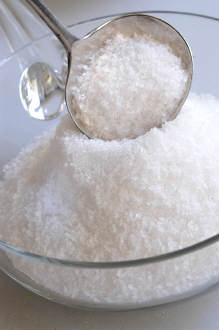Health > Food And Diet > Salt
SALT

Salt and water - the body’s most basic constituents are essential to life, and it is salt which controls many of the body’s vital mechanisms by regulating fluid levels.
Salt is a very simple chemical compound composed of two elements, sodium and chlorine, which give it its chemical name, sodium chloride. In the body it is dissolved in water, and in this state the sodium and chlorine parts separate and move independently as sodium and chlorine ions, or electrically charged particles similar to atoms.
The body’s salt content occurs in the ratio of three parts of sodium to two of chlorine. In practice, when doctors refer to salt retention and loss, they mean sodium retention and loss, with the assumption that chlorine always coexists with sodium.
WHERE IS SALT FOUND ?
Salt is found in all body’s fluids but there is much more in the blood and the extra cellular fluid than in the fluid inside cells, and for good reason.
There is a balance maintained between the extra cellular fluid containing sodium and the similar solution inside which contains the complementary element potassium. All cell have a mechanism for pumping sodium outwards while keeping potassium inside. This is aptly called the sodium pump and most of the body’s energy is taken up in the ceaseless activity of these tiny pumps. The cell therefore act in similar way to single-celled animals in the sea which keep their salt levels low compared with sea water surrounding them.
FUNCTION AND SOURCES OF SALT
Salt has the function of maintaining all the body’s fluids at an optimum level. This comes about because the volume of a fluid depends directly on the amount of the salt dissolved in it. Thus, since the amount of salt in the body is itself rigidly controlled the volume of blood and other fluid is thereby regulated.
We take salt in its pure form but it is also present in meat and vegetables and in large quantities in some processed foods like potato crisps and peanuts.
HOW THE SALT LEVEL IS CONTROLLED ?
The body loses salt in the urine and sweat. The plasma, or liquid part of the blood, passes out into the urine and the parts are then taken in by the kidney tubules. Salt is reabsorbed from the tubular fluid in the kidneys, and the water also needed by the tends to follow by osmosis, the process whereby a sustained (such as water in this case) passes across membranes from a weaker solution to a stronger one. Water will therefore leave the kidney tubules when they have lost slat and pass into the blood that has a higher salt content than the kidneys.
The kidneys are thus very important in controlling salt levels in the body and the balance tends to be disturbed particularly by factors acting directly on the kidneys. For example, the steroid hormone aldosterone makes the kidneys retain more salt than usual, while other steroid hormones, such as cortisone, have a similar but less marked effect.
Since the volume of blood is controlled chiefly by the salt level, any fall-off in the amount of blood reaching the kidneys will give the impression that the salt level is too low. Therefore the kidneys will tend to retain salt in an effort to restore the blood to its normal level. The kidneys behave in this way when there are heart problems. The salt levels then increase, giving rise to greater amounts of fluid in the circulation. Eventually there is too much blood for the heart to cope with and heart failure sets in. This explains why diuretic tablets, or water pills, are use to control heart failure since their function is to make the kidneys lose sodium in urine.
Salt loss through sweating is less easily controlled, so that in hot climate for example, more salt then usual should be taken or serious illness can result.
SALT LOSS
When there is a salt loss the body tries to keep enough fluid in the circulation for the heart to work effectively. Eventually it is unable to meet the body’s requirements and collapse follows.
Dehydration through sweating, vomiting and diarrhea can all do this, particularly in the case of babies and small children to have low salt levels in their bodies and so can afford to lose much less. Treatment is to give large doses of salty water (saline) preferably into a vein. Salt loss and water loss nearly always go together and so are treated accordingly.
Salt loss also occurs with a failure in the production of steroid hormones, although this involves less water loss. A low blood pressure and a tendency to collapse are among the symptoms of such failure, which known medically Addison’s disease.
|

